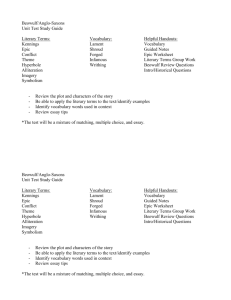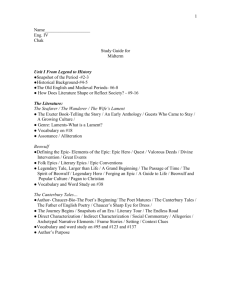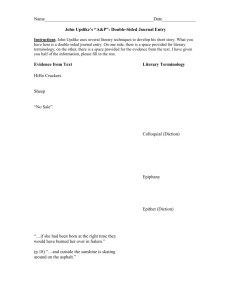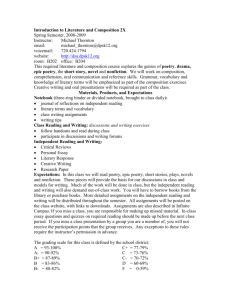English 11 Curriculum Map - Cumberland School Department
advertisement
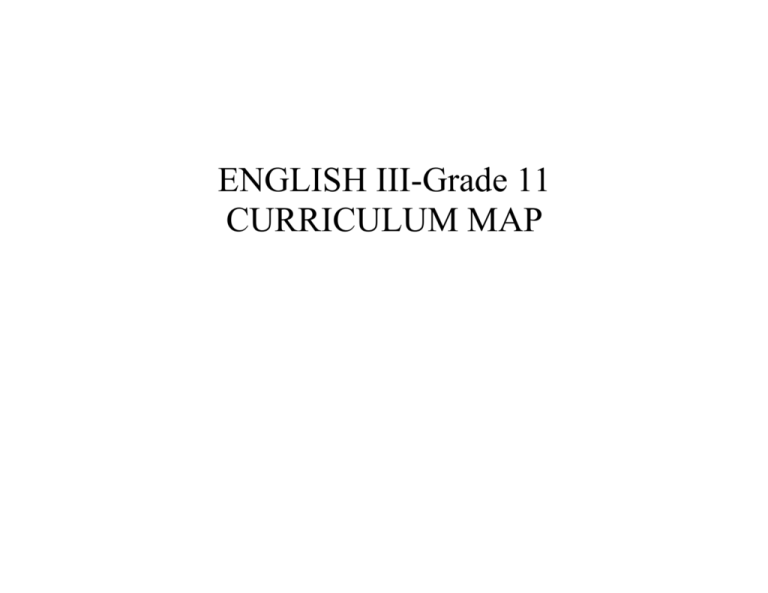
ENGLISH III-Grade 11 CURRICULUM MAP English 1: Literary Genres English 2: American Literature English 3: British Literature English 4: World Literature Reading: § Night § Romeo and Juliet § Poetry unit § Short Story unit § Reading strategies § Critical reading skills § Vocabulary acquisition Reading: § The Crucible § Fever § Independent reading selection § Of Mice and Men § Reading strategies § Critical reading skills § Vocabulary acquisition Reading: § Beowulf § Macbeth § Animal Farm § On Demand Writing unit § Reading strategies § Critical reading skills § Vocabulary acquisition Reading: § Hamlet § Personal statement § Anthem § Little Prince § Reading strategies § Critical reading skills § Vocabulary acquisition Writing: § Analytical writing skills § Resume writing § Research skills § Literary analysis § Expressive writing skills § Informational writing skills Writing: § Analytical writing skills § Personal essay writing § Research skills § Literary analysis § Expressive writing skills § Informational writing skills Speaking: § Informal speaking techniques § Formal speaking techniques Speaking: § Informal speaking techniques § Formal speaking techniques Sample thematic topics: § Periods of British literature § Conventions of British lit § Heroic tradition § Elizabethan England § Satire § Social issues § Nature vs. civilization § Colonialism § Victorianism § Industrial Revolution § Empire § Enlightenment Sample thematic topics: § Identity § Truth § Justice § Diaspora § Fate vs. free will § Alienation § Heroism § Modernism § Postmodernism § Cultural practices § Thematic oppositions § Initiation Writing: § Writing process § Grammar skills § MLA format § Critical writing skills § Expressive writing skills § Informational writing skills Speaking: § Informal speaking techniques § Formal speaking techniques Sample thematic topics: § Genre characteristics § Archetypal characters § Archetypal plots § Archetypal images § Allegory § Holocaust § Mythology § Renaissance § Irony § Story elements § Poetic devices § Figurative language Writing: § Analytical writing skills § Grammar skills § Research skills § Literary analysis § Expressive writing skills § Informational writing skills Speaking: § Informal speaking techniques § Formal speaking techniques Sample thematic topics: § Periods of American lit. § Conventions of American lit. § Puritanism § McCarthyism § Romanticism § Transcendentalism § Realism § Naturalism § Modernism § Postmodernism § Native American lit. § American Dream CURRICULUM PLANNING—GRADE 11: BEOWULF UNIT Essential Question: What makes a hero? Have the forces of good and evil changed over time and if so, how? How do different cultures shape the definitions of good and evil in epic poetry and other genres of literature? Assessments Student Understandings Summative Assessment: Ø MLA response to literature thesis driven essay: analyzing character traits of the main character as they are linked to the themes of Beowulf. Guiding Questions: Ø What are the poetic devices used by the author, and how are they use? Ø What are the major epic characteristics and how are they applied by the author? Ø What specific character traits distinguish an epic hero from other hero types? Ø How is oral tradition utilized by the author to convey the cultural values of the Anglo-Saxon people? Ø How does the central conflict in the epic relate to the traits of an Anglo-Saxon hero? Ø What specific evidence of Anglo-Saxon her characteristics can be found in the poem? Continuous Assessments: Ø Student prior knowledge and zone of proximal development Ø Student makes connections to other texts and broader world application Ø Student application of teacher modeled thinking strategies through oral and written responses Ø Citing information in oral and written responses Ø Student ability to respectfully and responsibly listen and respond to others. Ø Student understanding of literary elements and author’s craft through oral and written response. Ø Students demonstrate skills applicable to SAT’s testing. Knowledge/Skills: Students will know/be able to : Ø Paraphrase and summarize analyze, interpret characteristics and elements of epic poetry in context appropriate to audience (R-10-4.1, R— 5.1-3) Ø Generate questions before, during, and after reading relating to the epic poetry genre, literary elements and devices, and author’s purpose (R10-4.3, R-10-6.1, R-10-16.1-2, R-10-13) Ø Demonstration use of the following literary elements and devices in analyzing epic poems: point-of-view, voice, diction, syntax, symbolism, irony, theme, climax, mood, allusions, foreshadowing, characterization, bias, extended Instructional Plan Suggested Materials: Ø Class set of Beowulf (required text) Ø Supportive text Ø Graphic organizers and ancillary materials Ø Exemplars and Rubrics Instructional Strategies/Suggested Scaffolds: Ø Cooperative learning Ø Graphic organizers Ø Pre-assessment test and tools Ø Modeling Ø Mini-lessons Ø Note-taking learning strategies Ø Think-alouds/read-alouds Ø Student/teacher conferencing Ø Written responses Rituals and Routines: (consider when planning) Ø Ø Ø Ø Differentiated instruction/UDL Student behavior expectations Academic expectations SAT prep Ø Ø Ø Ø Ø Ø Ø Ø Ø metaphor, and hyperbole and identify characteristics of a variety of types/genres of literature (R-10-4.4, R-10-4.5) Participate in in-depth discussions about epic poetry, ideas, and writing (R-10-17.2, OC-10-1.4) Demonstrate ability to monitor comprehension and read critically through techniques such as annotating (R-10-12.1) Use MLA format and formal writing guidelines in a response to literature (W-10.6.5) Identify literary devices as appropriate to poetry (alliteration, foreshadowing, metaphors, similes, repetitions, symbolism, point of view, diction, and flashback) (R-10-4.5) Use strategies to unlock meaning (e.g., knowledge of word structure, common roots, word origins; or context clues or resources including dictionaries and glossaries, to determine definition, pronunciation, etymology, or usage of words; or prior knowledge(R-1010.2) Explain and support logical predictions and outcomes, drawing conclusions based on interactions between characters or evolving plot (R-10-5.2) Connect reading to prior knowledge, other texts, and a broader world context through relevant themes, motifs, and archetypes (W-10-2.3) Use specific details and references to text relevant to citations to support thesis, interpretations, or conclusions and organize ideas using transitions, and drawing conclusions by synthesizing information and connecting to broader world ideas (W-10-3.3-4) Use an organizational structure that allows for the progression of ideas to develop, including an opening, body and closure(W-10-.1-4, 3.4; W-10- Ø 4.6; W-10-14.3, 3) Demonstrates control of usage, grammar punctuation, sentence construction, and spelling(W-10-9.1-5) Suggested Applications: Ø Class discussions Ø Reading logs Ø Reading quizzes Ø Homework assignments Ø Independent and group work Ø Independent and group projects Ø Journal responses Ø Quote analysis CURRICULUM PLANNING—GRADE 11: MACBETH UNIT Duration: 4-6 weeks Essential Question: Are heroes flawed? Have the forces of good and evil changed over time and if so, how? How do different cultures shape the definitions of good and evil in epic poetry and othe genres of literature? Assessments Summative Assessment: Ø MLA response to literature thesis driven essay: analyzing character traits of the main character, Beowulf Ø Unit test (with questions formatted to give NACAP practice) Continuous Assessments: Ø Student prior knowledge and zone of proximal development Ø Student makes connections to other texts and broader world application Ø Student application of teacher modeled thinking strategies through oral and written responses Ø Citing information in oral and written responses Ø Student ability to respectfully and responsibly listen and respond to others. Ø Student understanding of literary elements and author’s craft through oral and written response. Ø Students demonstrate skills applicable to SAT testing. Student Understandings Guiding Questions: Ø What are the poetic devices used by the author, and how are they use? Ø What are the major characteristics of drama and how are they applied by the author? Ø What specific character traits distinguish a tragic hero from other hero types? Ø How does culture influence literature and literature influence culture? Ø How does the central conflict in a play relate to the traits of a tragic hero? Ø How can the study of themes and values in texts prepare one for responsible participation in society? Ø How is dialect used to accomplish the author’s purpose? Knowledge/Skills: Students will know/be able to : Ø Paraphrase and summarize analyze, interpret characteristics and elements of drama in context appropriate to audience (R-10-4.1, R—5.1-3) Ø Generate questions before, during, and after reading relating to the drama genre, literary elements and devices, and author’s purpose (R10-4.3, R-10-6.1, R-10-16.1-2, R-10-13) Ø Demonstration use of the following literary elements and devices in analyzing drama: poiny-of-view, voice, diction, syntax, symbolism, irony, theme, climax, mood, Instructional Plan Suggested Materials: Ø Macbeth by William Shakespeare (required text) Ø Supportive text Ø Graphic organizers and ancillary materials Ø Exemplars and Rubrics Instructional Strategies/Suggested Scaffolds: Ø Cooperative learning Ø Graphic organizers Ø Pre-assessment test and tools Ø Modeling Ø Mini-lessons Ø Note-taking learning strategies Ø Think alouds/read alouds Ø Student/teacher conferencing Ø Written responses Rituals and Routines: (consider when planning) Ø Ø Ø Ø Differentiated instruction/UDL Student behavior expectations Academic expectations SAT prep Ø Ø Ø Ø Ø Ø Ø Ø Ø allusions, foreshadowing, characterization, bias, extended metaphor, and hyperbole and identify characteristics of a variety of types/genres of literature (R-10-4.4, R-10-4.5) Participate in in-depth discussions about drama, broader world applications, and writing (R-1017.2, OC-10-1.4) Demonstrate ability to monitor comprehension and read critically through techniques such as annotating (R-10-12.1) Make logical predictions about character, setting, and plot/subplots and identify dynamic characters, relationships or setting over time (R10-4.1) Use MLA format and formal writing guidelines in a response to literature (W-10.6.5) Identify literary devices as appropriate to drama(alliteration, foreshadowing, metaphors, similes, repetitions, symbolism, point of view, diction, and flashback) (R-10-4.5) Use strategies to unlock meaning (e.g., knowledge of word structure, common roots, word origins; or context clues or resources including dictionaries and glossaries, to determine definition, pronunciation, etomology, or usage of words; or prior knowledge(R-1010.2) Explain and support logical predictions and outcomes, drawing conclusions based on interactions between characters or evolving plot (R-10-5.2) Make inferences about cause/effect conflict or relationships amoung elements of text (R-10-5.3) Identify the author’s purpose and how the author’s style is evident and affects the reader’s interpretation and is supported throughout the text (R-10-5.4, 5.6) Ø Ø Ø Ø Connect reading to prior knowledge, other texts, and a broader world context through relevant themes, motifs, and archetypes (W-10-2.3) Use specific details and references to text relevant to citations to support thesis, interpretations, or conclusions and organize ideas using transitions, and drawing conclusions by synthesizing information and connecting to broader world ideas (W-10-3.3-4) Use an organizational structure that allows for the progression of ideas to develop, including an opening, body and closure(W-10-.1-4, 3.4; W10-4.6; W-10-14.3, 3) Demonstrates control of usage, grammar punctuation, sentence construction, and spelling(W-10-9.1-5) Suggested Applications: Ø Class discussions Ø Reading logs Ø Reading quizzes Ø Homework assignments Ø Independent and group work Ø Independent and group projects Ø Journal responses Ø Quote analysis CURRICULUM PLANNING—GRADE 11: ON DEMAND WRITING UNIT Duration: 1-2 weeks Essential Question: What is the value of personal writing as a tool for thinking, solving problems, exploring issues, constructing questions, and addressing inquiry in daily application of knowledge? Assessments Student Understandings Summative Assessment: Ø “One should be more concerned about what his conscience whispers than about what other people shout” Select a significant or event in your life or the life of someone close to you that exemplifies the meaning of this quotation. Write a reflective essay that analyzes the relationship between this quotation and the specific situation or event you have chosen(required common task) Guiding Questions: Ø How do authors communicate purposefully and clearly with various audiences in personal and reflective writing pieces? Ø How can writing communicate ideas and deepen understanding? Ø How does revising and editing strengthen ideas, organization , voice word choice, sentence fluency, and conventions Ø How is style controlled by syntax, diction, point of view? Ø How do effective writers hook and hold readers and make writing easy to follow? Ø What skills are necessary to give and seek information in conversations, in group discussions, and in oral presentations? Ø How does writing develop reflective abilities and metacognition? Continuous Assessments: Ø Student prior knowledge and zone of proximal development Ø Student makes connections between a variety of texts and broader world application Ø Student application of teacher modeled thinking strategies through oral and written responses Ø Citing information in oral and Knowledge/Skills: Students will know/be able to Ø Organize information to show understanding or relationships among facts, ideas, and events(e.g., representing main/central ideas or details within text through charting, mapping, Instructional Plan Suggested Materials: Ø Writing handouts, guidelines, and assigments Ø Supportive text Ø Graphic organizers and ancillary materials Ø Exemplars and Rubrics Instructional Strategies/Suggested Scaffolds: Ø Cooperative learning Ø Graphic organizers Ø Pre-assessment test and tools Ø Modeling Ø Mini-lessons Ø Note-taking learning strategies Ø Think alouds/read alouds Ø Student/teacher conferencing Ø Written responses Ø Ø Ø Ø written responses Student ability to respectfully and responsibly listen and respond to others. Student understanding of literary elements and author’s craft through oral and written response. Student participation Students demonstrate skills applicable to SAT testing. Ø Ø Ø Ø Ø Ø Ø Ø paraphrasing, summarizing, comparing/contrasting, outlining(R-10-7.3) Read multiple texts for depth of understanding a subject or genre(R-10-14.3) Participating in in-depth discussions about text, ideas, student writing by offering comments, and supporting evidence, responding to the comments and recommandations of peers, teachers, and others(R-10-17.2, OC-10-1.4, R-1014.3) Establish context by selecting and summarizing key ideas appropriate to audience(W-10-2.1, W10-14.1) Establish an interpretive claim/assertion in the form of a thesis when responding to a given prompt(W-10-3.1a) Use precise and descriptive language that clarifies and supports intent and establishes an authoritative voice 9W-10-7.4-5) Demonstrate ability to monitor comprehension and read critically through techniques such as annotating (R-10-12.1) Use an organizational structure that allows for the progression of ideas to develop, including an opening, body and closure(W-10-.1-4, 3.4; W10-4.6; W-10-14.3, 3) Demonstrates control of usage, grammar punctuation, sentence construction, and spelling(W-10-9.1-5) Suggested Applications: Ø Pre-tests Ø Class discussions Ø Reading logs Ø Reading quizzes Ø Homework assignments Ø Independent and group work Rituals and Routines: (consider when planning) Ø Ø Ø Ø Differentiated instruction/UDL Student behavior expectations Academic expectations SAT prep Ø Ø Ø Ø Independent and group projects Journal responses Quote analysis Presentations

